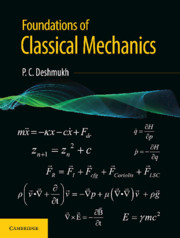Book contents
- Frontmatter
- Dedication
- Contents
- List of Figures
- List of Tables
- Foreword
- Preface
- Introduction
- 1 Laws of Mechanics and Symmetry Principles
- 2 Mathematical Preliminaries
- 3 Real Effects of Pseudo-forces: Description of Motion in Accelerated Frame of Reference
- 4 Small Oscillations and Wave Motion
- 5 Damped and Driven Oscillations; Resonances
- 6 The Variational Principle
- 7 Angular Momentum and Rigid Body Dynamics
- 8 The Gravitational Interaction in Newtonian Mechanics
- 9 Complex Behavior of Simple System
- 10 Gradient Operator, Methods of Fluid Mechanics, and Electrodynamics
- 11 Rudiments of Fluid Mechanics
- 12 Basic Principles of Electrodynamics
- 13 Introduction to the Special Theory of Relativity
- 14 A Glimpse of the General Theory of Relativity
- Index
3 - Real Effects of Pseudo-forces: Description of Motion in Accelerated Frame of Reference
Published online by Cambridge University Press: 06 November 2019
- Frontmatter
- Dedication
- Contents
- List of Figures
- List of Tables
- Foreword
- Preface
- Introduction
- 1 Laws of Mechanics and Symmetry Principles
- 2 Mathematical Preliminaries
- 3 Real Effects of Pseudo-forces: Description of Motion in Accelerated Frame of Reference
- 4 Small Oscillations and Wave Motion
- 5 Damped and Driven Oscillations; Resonances
- 6 The Variational Principle
- 7 Angular Momentum and Rigid Body Dynamics
- 8 The Gravitational Interaction in Newtonian Mechanics
- 9 Complex Behavior of Simple System
- 10 Gradient Operator, Methods of Fluid Mechanics, and Electrodynamics
- 11 Rudiments of Fluid Mechanics
- 12 Basic Principles of Electrodynamics
- 13 Introduction to the Special Theory of Relativity
- 14 A Glimpse of the General Theory of Relativity
- Index
Summary
The creative principle resides in mathematics. In a certain sense, therefore, I hold true that pure thought can grasp reality, as the ancients dreamed.
—Albert EinsteinGALILEO–NEWTON LAW OF INERTIA—AGAIN
One of my favorite experiments when I have fastened the seatbelt in an airplane ready to take-off, is to drop an object, say a pen (since they do not give a chocolate anymore.), from one hand into the other. At the beginning of the run, when the plane is at rest, the pen drops ‘vertically’ down, straight into the palm of the other hand beneath it. As the plane speeds up on the runway, the pen drops backward, missing the palm, hitting my chest. The line along which the pen falls would generate for me a perception of the ‘vertical’. The line along which the pen falls is clearly different when the plane is at rest, and when it is accelerating on the runway. It could also change my perception of gravity, as I would think of it to be along the space curve of the falling pen's path. The perception of gravity which an observer in an inertial frame of reference has, is therefore clearly different from that of another in an accelerated frame of reference. To understand acceleration in different frames, we must therefore examine the cause that changes the equilibrium of an object.
We all have an intuitive idea of what equilibrium is. It is, however, important to underscore that objects not merely at rest but also those which are moving at a constant momentum, are essentially in a state of equilibrium. The latter form of equilibrium is almost counter-intuitive. It is contrary to common experience, because motion is resisted by friction. In order to maintain constant momentum, application of force is then necessary to overcome friction. Galileo recognized the essence of equilibrium by carrying out innovatory experiments, such as rolling objects on inclined planes, and dropping objects from the top of the mast of a ship (discussed in Chapter 1).
Galileo Galilei was born in 1564 to a distinguished musician, an expert lutenist, Vincenzo Galilei. Galileo not only grew into an expert lutenist himself, but also became a man of exceptional scholarship and contributed pioneering works in astronomy, physics, mathematics, philosophy and also engineering.
- Type
- Chapter
- Information
- Foundations of Classical Mechanics , pp. 78 - 110Publisher: Cambridge University PressPrint publication year: 2019



